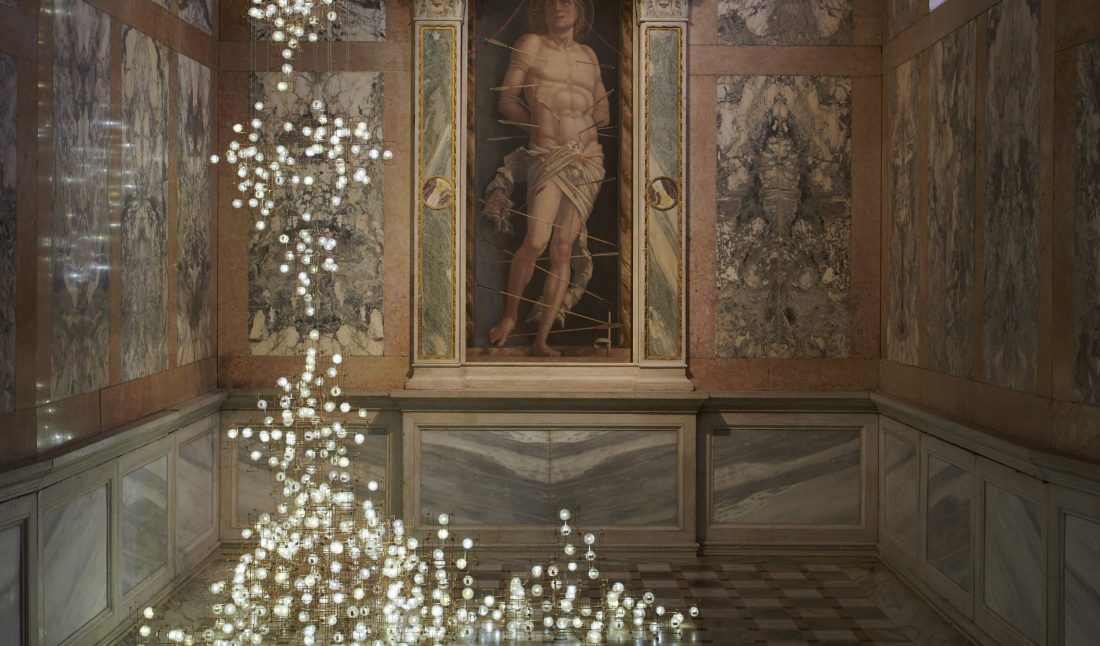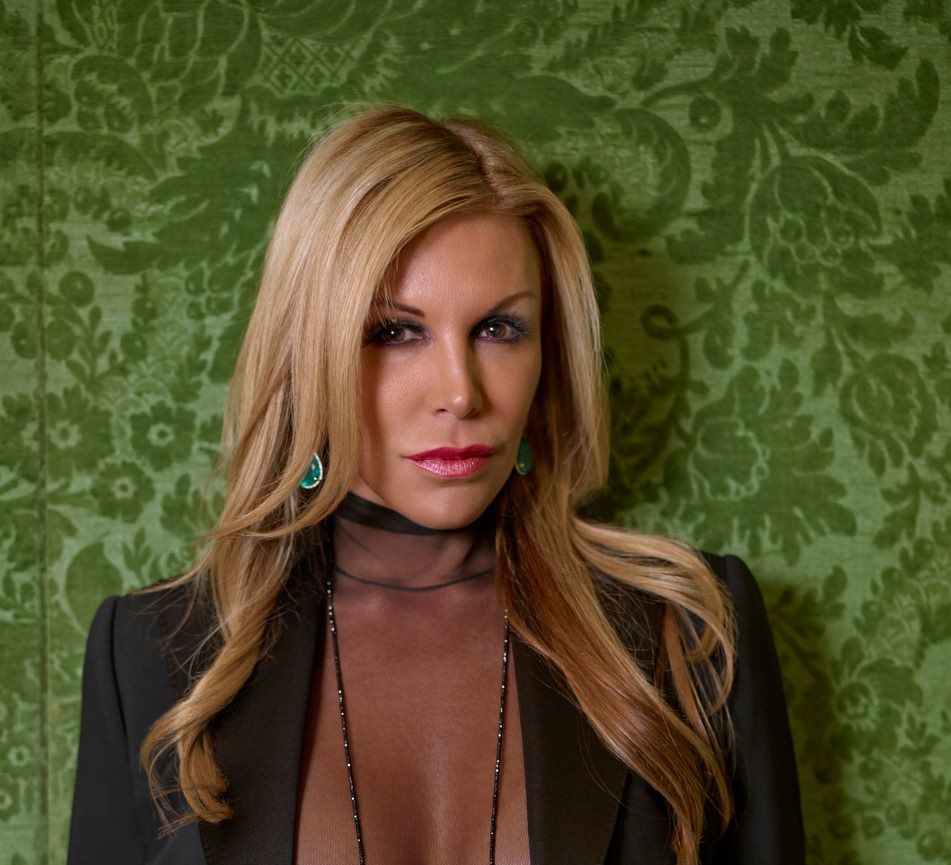For decades, neuropsychologists have examined the brain, theorizing that people are either left-brained or right-brained. The left side controls logic and analytical thinking, while the right side operates creativity and imagination. Drawing upon this parallel, we see Studio Drift as a scientific marvel—an art and design studio that operates from both simultaneously. Its founders, Lonneke Gordijn and Ralph Nauta, are both wildly emotionally intelligent and innately understanding of the balance between nature and technology.
In their work, this intersection serves as a source for ongoing inspiration. Works like Fragile Future, Flylight, and Franchise Freedom use technology to enlighten our understanding of existence on Earth. Their creative direction is powerful, packed with meaning, theory, imagination, and purpose.
Whitewall spoke with Gordijn and Nauta about their beginnings with technology in their practice and where they think humankind’s relationship with it is headed.
WHITEWALL: Can you tell us a bit about where your journey with technology began?
RALPH NAUTA: My journey began as a kid. I was fascinated by the dream worlds in Star Wars, Ghostbusters, and The Goonies. Stimulated by our father, my brother, Robert, and I played around with the first programmable toys like Big Trak and Simon. Where I was always careful not to break anything, Robert would be more bold by taking everything apart, not being able to put it back together again. I was always looking over his shoulder, learning.
Later on, I got my first Tamiya self-build remote-controlled car that I can proudly say still runs. At a young age, I was learning to combine mechanics and electronics to make the world around us move. We were overclocking— reprogramming to make it faster—my 486 Intel PC with 40 GB hard drive to play the latest games. We were building our own printed circuit boards with the first LEDs to make the light move like the front of KITT in Night Rider. We moved on to real cars, stripping and rebuilding an old Beetle to make it faster, that we integrated in our “Materialism” series.
My journey became even more extraordinary and interesting once knowing Lonneke, through our endless conversations. We were madly in love and totally open to each other’s opinions. We discovered that our personal interests and seemingly opposite interests—like ourselves—had a strong link to each other; that the wonders of the natural and technical man-made world are strongly rooted into each other’s existence. Up to this day we keep exploring the relationships between them, knowing from that point on, if we wanted to change the world, we would need to step up our A game and develop it!
LONNEKE GORDIJN: When I was a child, I was fascinated by nature and spent hours lying in the grass watching the microscopic world of ants and flowers in front of me. Fragile Future was my graduation project. I was never really interested in making functional objects. Moreover, I wanted to understand what level of awareness on humanity or the environment an object could raise. Fragile Future uses the fragility of dandelion seeds as a strength and poses its ability to make a meaningful connection with a completely different human system. As I am extremely intrigued by everything that drives evolution, technological innovation and nature are a natural fit for me, when developing a perspective for our future.
It was a total coincidence that one day I picked a dandelion from my garden and discovered its head has exactly the same size as an LED lightbulb. I glued, one by one, the parachute seeds with tweezers on the LED and immediately knew this meant much more than only making a beautiful image. Connecting electronic circuits with natural components was the first step toward the later development of our works, where we aim to reestablish the connection between humankind and the earth.
WW: What was the first piece in which you used technology to push boundaries?
LG: The first programmable piece of art we made together was Shylight, whereby we were developing our own programmable electronic boards to control lights and motors from scratch. This journey was intense and took all our childhood savings and determination. We were so broke we didn’t have cash for food or rent. We tried to show them in Milan . . . a disaster and almost a career-ender. At that point we didn’t know the value of our development as we were creating our own Arduino micro control platform. Now you can buy one for 15 euros and start playing around. You need to be a lot more sure of the results you want to achieve to pour all your savings into a development that most likely won’t work.
RN: Flylight might have been earlier in 2007, but this was a project by Lonneke that I later joined in on. It still is one of my favorite pieces; that runs on our self-developed interactive swarm algorithm software, with the help of our friend Luuk van Laake. It is a key work for us, as it’s the basis of Franchise Freedom— our drone artwork that we, after ten years of developing, finally launched at Art Basel Miami 2017 with the help of BMW, Intel, and Faena.
WW: How has your practice evolved, as technology and other inventions have advanced?
LG: The ideas we work on are still the fundamental questions we had when growing up. Through our work, we have learned why we do certain things and why they are interesting for us. Still today, we discover new nuances within our own work we didn’t think of before. Because we are running a 50-person studio, we can lose the ability to look, feel, and connect to what we are doing. Taking a step back and reconnecting is essential in our work. I have a more natural way of doing this, but Ralph has to force himself to reconnect in this way.
RN: For one of the programmable platforms, we now use a more stable and easier-to-program hardware than in the past, making it easier—not easy—and more interesting to push our work forward. It’s an interesting time to be doing what we do as AI and new ways of sensory input become more relevant and logical to implement in our work. In the past, we had to work for years to get one electrical or technical feature under control. Now we can work with interesting tech developers like Intel to create our work, giving us more freedom and time to work on the nuances to connect to the audience.
WW: Your work has long explored the boundaries of technology and the impossible. What’s the most recent impossible situation you’ve been exploring?
RN: As always, the influence of our ever-altered human condition in an unnatural manner by the technology that is pushing us away from our natural connection, wondering how we can use that same tech to reconnect our relationship with nature and ourselves.
We are exploring the influence of the vastness of space on our minds in relationship with the endless in-your-face commercialism humans have created. Instead of just connecting with the latter, we try to use it to generate a positive, world-changing stimulant. We are again developing new tech for this project to make sure we have the most control possible for the desired goal. As always, total control is impossible and maybe not even desired. But we can try to get as close as we can.
WW: Tell us about your new body of work,“Materialism,” presented this year at Frieze Los Angeles and TEFAF.
LG: “Materialism” is an ongoing research project in which we explore the everyday made objects that surround us. We have reduced everyday products— such as a vacuum cleaner, an automobile (a VW Beetle in relationship to Ralph’s past), a pencil, and a bicycle—to the exact quantity of the specific raw materials which comprise them, shown in the form of blocks in a 2:1 dimension that we always work with.
We are confronting the viewer on a very elementary level with the objects we choose to decommission. “Materialism” inspires contemplation of the raw materials at our daily disposal that create the world we live in. We are also deconstructing one of the first TVs compared to a new one. The materials from both show where in the world, during its creation, the geopolitical pressure was for the control of material streams in their time.
WW: Why did you want to take a closer look at raw materials at our daily disposal?
LG: To unveil the mysteries of nature, to understand its materiality, and begin to question humanity’s relationship to it. Civilization has introduced millions of new “artificial species” through the ecosystems of commerce—objects that support our pleasant, contemporary existence and contain myriad materials forged together by design—yet we feel disconnected from this materiality today, blind to the inner workings and composition of all these artificial things.
We “de-produced” the produced, deconstructing familiar things about which we tend only to consider their function. We make clear how much of the matter within these objects is extracted from the earth. In the process, we reverse the mandates of engineering required for mass production, which are standardization, modularization, and abstraction. We essentially create uniqueness, unity, and “de-abstraction” in the form of simple geometric blocks. These blocks of varied, pure color make visual rhymes with the earliest works of abstract art, such as the paintings of Kazimir Malevich, Hilma af Klint, and Piet Mondrian. Although the goal of “de-abstraction” may sound opposed to the work of these 20th-century artists, the purpose of their work and of “Materialism” is actually aligned—to make the essential nature of the world visible.
WW: In 2017 in Miami, we stood on the beach and watched Franchise Freedom connect in the sky with the use of 300 drones. Although the performance was highly tech-forward, it was a real-life wonderment that was experienced by so many people together. Tell us a bit about your mission to use technology to bring us together.
RN: We aim to create a moment of contemplation and silence for the viewer, experiencing a natural connection toward our tech-driven world. This means there must be a recognizable natural element present. Before we show the work, we endlessly adjust the programming until we feel what we see is beyond a random tech encounter that will only be interesting for ten minutes before moving on toward the next impulse. We do not develop tech and then make an art piece with it or take something off a shelf. We create a natural movement that can be endlessly watched and felt—like a campfire, the movement of waves, or the wind through the trees. This is easier said than done.
It’s these moments that make us rethink our potential future. We believe this is needed to alter our course and get closer to nature and our human nature. We are so over-etched that we need tech to snap out of it. Once opening up the mind of making the impossible possible in a very natural way, we can have a meaningful discussion to create a new narrative in what we should be investing our time in, and what we need to create. I constantly need to remind myself of this necessity.
WW: Your work often includes performance. What do you feel makes an engaging work of art?
RN: I want to be surprised, taken off guard, and stopped in my daily routine to open up my mind to feel and think. Working with unseen tech does that for us, as it makes the impossible possible. Like Clarke’s third law states, “Any sufficiently advanced technology is indistinguishable from magic.” It needs to be layered so I can constantly discover new elements of the story the artist is trying to tell me. I hope to come across work with a positive story.
LG: Creating a performance piece gives certain advantages over creating a permanent work. It demands a different way of attention. As the work is only visible for a certain period of time at a specific location, you have to make an effort to be part of it or forever miss the moment. The work then becomes a time capsule that you share with a certain group of people. This creates a connection with that group that after years can still be shared, felt, and contemplated on. This strong bond is more valuable than any physical object, as it can only be revisited in your mind, creating a work you can always take with you without physical baggage. Even going back to a place where a performance once was, or a connection that was made, can create a strong incentive to relive that moment.
WW: The age-old tale of “human meets machine” feels closer than ever, and our contemporary existence is arguably reliant, or at least heightened, by technology. Where do you think we’re headed?
RN: We like to show the technology that we use, and not hide printed circuit boards or motors under a surface. The idea is that you see the technological components, but not get the feeling that it feels distant or inhuman. Most of all, we like when a material has hardly any materiality.
We do not yet know the outcome of our tech-infiltrated way of life. To understand, we need to create tech-free zones, otherwise we will lose the ability to compare the two with each other—and with it, the capacity to reflect on the tech developments that are taking over our day-to-day life skills. Human interactivity is madly in danger. We are asking our tech what to do and losing our intuition! This is, at the moment, my biggest fear next to global warming. Instead of finding solutions to problems, we are evolving too fast, creating new layers of problems to solve to get to the original problem underneath.
Creating a sense of connectivity to our own technology is vital for our existence and the main theme in our work. We work to establish the connection between nature and tech to show that a natural connection can and should be made with the world we develop around us. I do believe that before we solve this imminent danger, all other conversations are irrelevant and slowing down the solutions, and we should be invested in our change for survival as we are madly running out of time. We need to put down our egos and individual fights of our position within culture and work together, otherwise we won’t have a culture to fight for.











